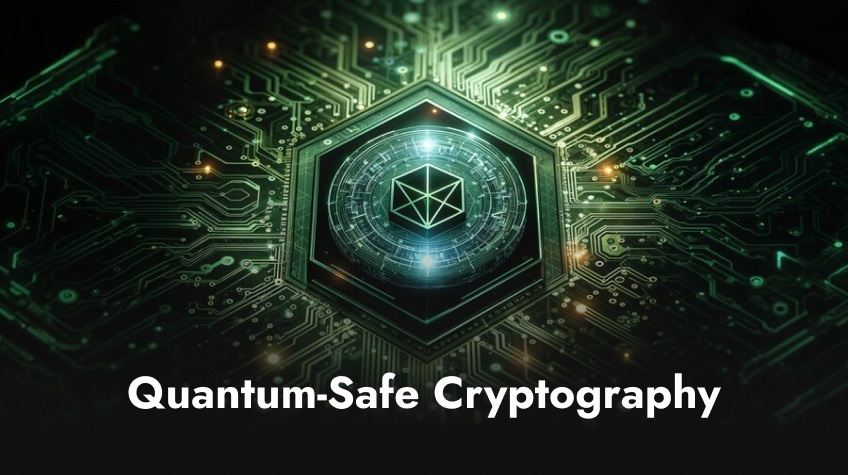
So many future developments and innovations lie ahead in the quantum cloud computing era. A few decades before, nobody anticipated the power of quantum cloud computers. However, now we know how quantum computers can solve the most complex mathematical problems at exceptional speed. And that’s the reason these quantum computers are making huge waves. Undoubtedly, these computers will transform the way industries function worldwide. Even government organizations and private agencies that are scared about its usage will get its benefits.
With advantages, there are some risk factors regarding its security standards in the cloud environment. Still, quantum computing has not developed. The talks about its cybersecurity vulnerability have taken over the whole internet. In this scenario, cloud providers have come to the forefront with a promising solution. They are introducing the next-generation cryptography called quantum-safe cryptography before the launch of quantum computers. They are preparing the whole world to overcome the challenges associated with quantum cloud computing. Their readiness is sure to transform the entire world.
So, if you are wondering how can you implement quantum-safe cryptography in the cloud infrastructure, then this post is for you. Here, you will learn how to implement quantum-safe cryptography in the cloud infrastructure with a discussion on quantum computing threats, the need for quantum-safe technology, types of quantum-computing cryptography, and more. So, let’s get started…
Table of Contents
- What Exactly is Quantum-Safe Cryptography?
- What is a Quantum-Safe Network?
- Types of Quantum Safe Cryptography
- Symmetric Key Algorithms
- Lattice-based Cryptography
- Code-based Cryptography
- Multivariate Based Cryptography
- Hash-based Cryptography
- Isogeny-based Cryptography
- Need for Quantum-Resistant Cryptography in Cloud
- Implementing Quantum-Safe Cryptography in Cloud Structure
- Challenges in Implementing Quantum-Safe Cryptography
- Challenge No. 1: Modification in the Infrastructure
- Challenge No. 2: Trust and Credibility
- Challenge No. 3: Sharing Network Infrastructure
- Challenge No. 4: Costly Set Up
- Use Cases for Quantum-Safe Cryptography in Cloud Environments
What Exactly is Quantum-Safe Cryptography?
Quantum-safe cryptography (QSC), often referred to as post-quantum cryptography (PQC), is the newest cryptographic algorithm designed to be secure against quantum computers. They operate on existing computers and networks. Quantum-safe cryptography algorithms are built on mathematical problems that are difficult for both Quantum Computers and classical computers to solve. This is just the opposite of what public key cryptography (PKC) does. PKC is built on problems that can be solved by a quantum computer in a few hours.
What is a Quantum-Safe Network?
A quantum-safe network is a set of advanced technologies and security that update their algorithms as threats evolve. It ensures the cryptographic building blocks are harder to break for malicious actors. This way, it defeats the threat of quantum computing and builds trust in data. It prevents data distortion during data processing or transmission. The good thing is that this is not rigid or incompatible with future changes or developments. Instead, it is highly scalable and flexible.
Also Read: What is Quantum Threat Intelligence and Steps to Prevent Threat
Types of Quantum Safe Cryptography
Quantum-safe cryptography’s implementation is essential to building trust in data and mitigating risk. Otherwise, the sensitive information of both small and large organizations will be at a higher risk at all times. Here is the list of different types of Quantum Safe Cryptography that you must be aware of. Take a look…
1. Symmetric Key Algorithms
Symmetric key algorithms have proved themselves efficient quantum-computing resistant. This ensures the transmission of data and encryption keys separately.
2. Lattice-based Cryptography
Lattice-based cryptography is another variation of quantum-safe cryptography. It is known for its flexibility, scalability, and efficiency. Most importantly, it uses complex mathematical lattices or robust cryptographic building blocks to withstand the challenges of quantum computing.
3. Code-based Cryptography
Code-based quantum-safe cryptography comprises symmetric or asymmetric cryptosystems. This, in turn, makes the decoding of a linear error-correcting code difficult for cyberattacks.
4. Multivariate Based Cryptography
The next type of Quantum Safe Cryptography is Multivariate based cryptography. Quantum-safe multivariate-based cryptography relies upon a new quantum-safe digital signature algorithm. It is also known as Multivariate Polynomial Public Key Digital Signature (MPPK/DS). However, it has a significant downside, which is the large size of public keys.
5. Hash-based Cryptography
Hash-based cryptography creates robust digital signatures to resist quantum computing-based attacks. Hash functions are not based on complex mathematical problems like factoring prime numbers. Usually, quantum computers are faster. They are able to solve prime factors faster than classical computing systems. Therefore, the hash-based variant is one of the most effective and reliable quantum-safe cryptography forms.
6. Isogeny-based Cryptography
Last but not least is Isogeny-based cryptography. It is one of the most advanced cryptographies. This advanced form of cryptography uses the properties of elliptic curves to create stronger mathematical cryptographic solutions for malicious users.
Need for Quantum-Resistant Cryptography in Cloud
Though quantum cloud computing’s potential advantages to businesses are many, a risk of data accessibility to malicious internet actors persists. Hence, a technology that can withstand quantum computing-based attacks is essential. The most talked-about security measure is quantum-resistant cryptography, which helps businesses look ahead to traditional cryptography. The current cloud computing is good for safeguarding data security and privacy, but the question is, “Can it address the rapidly growing quantum computing technology challenge?”
Quantum-resistant or quantum-safe cryptography in the cloud is critical to ensure a safe and secure future for small or large industries. This will help them gear up to take preventative measures against the hypersensitive nature of quantum computing for cybersecurity.
Implementing Quantum-Safe Cryptography in Cloud Structure
Fear not! Before the threat of quantum computing hits, Google, Apple, Microsoft Azure, and IBM would have actively implemented quantum-safe cryptography protocols in their cloud infrastructure. All these tech-giants aim to protect data and communications across different organizations.
Several US organizations, such as the National Security Agency (NSA), the Cloud Security Alliance (CSA), the Cybersecurity and Infrastructure Security Agency (CISA), and the National Institute of Standards and Technology (NIST), are implementing regulations for quantum computing power.
Furthermore, European government agencies, Indian or US military forces, Singapore, Japan, South Korea, and more are heading toward quantum-safe networks. This ensures a robust communication infrastructure against the decoding strength of malicious users.
A quantum-safe network is a need of an hour. It ensures the cryptographic building blocks are harder for malicious actors to break. This helps alleviate the threat associated with quantum computing and builds trust in data. It prevents data distortion during data processing or transmission. The best part is that it is highly scalable, flexible, and compatible with future changes or developments.
Presently, quantum-safe cryptography solutions use the power of symmetric key algorithms that send decryption and encryption keys separately. This prevents bad actors from accessing data.
Another significant key is quantum key distribution (QKD). The best part is that it does not employ math problems for encryption. Instead, it uses the physical properties of photons. This makes the interception of third-party keys and quantum hacking impossible. Additionally, post-quantum cryptography, with the evolution of public key cryptography, can complement symmetric key algorithms and quantum key distribution.
Here are some things that organizations should learn about quantum-safe computing environments:
- Quantum Safe Algorithms: Some cloud services offer secure cryptographic keys used by the US National Institute of Standards and Technology. These keys are cyber-safe exchange keys.
- Cloud Computing Libraries: This includes quantum-safe algorithms for cloud customers to test application use cases. Using these algorithms, organizations can integrate a quantum-safe infrastructure into their system.
- Quantum Key Distribution Trials: Cloud providers are conducting trials for quantum key distribution to ensure secure key exchange when quantum computing becomes mature. Organizations can access these trials to become familiar with these secured keys. This will prepare them for future developments.
Challenges in Implementing Quantum-Safe Cryptography
However, quantum computing is in its infancy. Still, many people are already talking about quantum-cryptography limitations and challenges to mitigate potential threats caused by the super-processing power of quantum computing. Let’s explore the following anticipated challenges that post-quantum cryptography may face for dynamic connectivity:
Challenge No. 1: Modification in the Infrastructure
The first thing to understand is how organizations should use quantum cryptography protocols to build a safe and secure environment. Their infrastructure should be able to utilize data security protection requirements. For this, they should make major modifications to their existing set of technologies. Otherwise, they would be unable to use quantum-safe cryptography against quantum computing attacks. Currently, quantum computing has been rapidly growing and adding more layers of complexity to defeat data security and privacy risks.
Challenge No. 2: Trust and Credibility
Quantum-safe cryptography has not gained the trust of the public sector, especially government agencies, so far. The hypersensitivity of quantum computing to cyberattacks has made it an unreliable technology. Despite several successful trials of cloud providers, it has not gained the trust of the public sector.
Challenge No. 3: Sharing Network Infrastructure
The next challenge in quantum-safe cryptography is the need for shared network infrastructure for safe and secure communication among organizations and applications. Setting a topology for multiple users to access shared communication is challenging. However, there is an effective solution to this problem. By introducing an intermediate node between two users, the problem can be resolved.
Challenge No. 4: Costly Set Up
Another challenge that has significantly impacted the efficiency of quantum-safe cryptography is the expensive setup. This is one of the major issues associated with quantum-safe cryptography and it needs to be addressed. The most important thing is that the existing communication infrastructure is not appropriate for quantum computing safety. The effective solution to this problem is the quantum states that are capable of traveling longer distances should be used. This will allow the adoption and development of cost-effective networks.
Use Cases for Quantum-Safe Cryptography in Cloud Environments
Now that you have learned the challenges and limitations associated with the implementation of quantum-safe cryptography, it’s time to learn use cases for it. Let’s understand how using quantum-safe cryptography can help various sectors in cloud environments. Here we go…
- Protect military and government agencies’ communications
- Secure real-time activities and transactions of banking and other financial institutions
- Assure the security of healthcare data records
- Safeguard personal data storage
- Restrict the access of third parties to sensitive corporate networks
The Bottom Line
So, this is all about the implementation of quantum-safe cryptography in cloud environments. Undoubtedly, implementing quantum-safe cryptography in cloud environments is crucial for future-proofing data security against the potential threats posed by quantum computing. Quantum computers with advanced cryptography are set to bring innovations across diverse industries. This ensures ultimate data protection and prevents third parties from accessing encryption and decryption keys. As cloud infrastructure plays a pivotal role in modern data storage and transmission, adopting cryptographic algorithms resilient to quantum attacks ensures the protection of sensitive information.
The implementation of advanced cryptographic tools and techniques is not going to be seamless for cloud providers. However, the right strategy and effective solutions can make cryptography accessible and cost-effective with quantum computing evolution. In addition, cloud providers, organizations, and regulatory bodies will need to collaborate to upgrade encryption standards, integrate new security protocols, and maintain compliance. By proactively implementing quantum-safe measures, cloud environments can stay ahead of emerging cyber threats, safeguarding data integrity in the quantum era. So, let’s pledge to have quantum-safe cryptography to fight against security threats.






